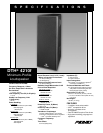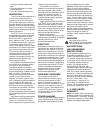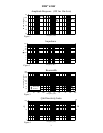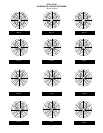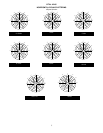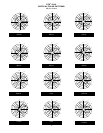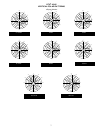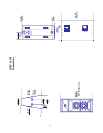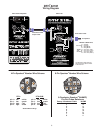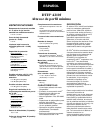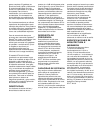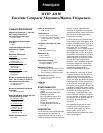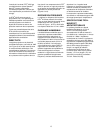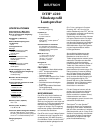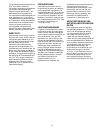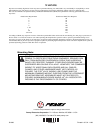
• 16-Gauge, powder coated metal
grille
• Externally switchable, full-range/
bi-amp operation
• 80° x 40° constant-directivity horn
DESCRIPTION
The DTH
®
4210f was designed as a
true minimum-profile enclosure. It
measures only 18-3/4" at its widest
point up front, tapering to a mere 9" at
the back. Because of the trapezoidal
geometry of these enclosures, building
arrays is much easier. This shape also
greatly reduces standing wave buildup
within the enclosure.
The DTH
®
4210f is a two-way, mid-
to high-frequency system utilizing two
SP10825 Scorpion
®
Plus mid-bass
drivers and a 44XT
™
compression
driver coupled to a CH
®
-7 horn, which
is a constant-directivity, 80
o
x 40
o
horn.
The mid-bass section of the DTH
®
4210f is horn loaded to improve output
and directivity. It is further augmented
by a critically optimized rear volume.
This air cavity’s primary function is
reactance annulling, which improves
and extends the low-frequency
response. Its secondary function is to
optimize transient response and
improve power handling.
As an additional improvement to the
sonic quality of the mid-bass section,
one of the 10" drivers has been
mounted backwards (its electrical
polarity has also been reversed so that
its acoustical polarity is identical to the
other 10" driver). This anti-axial
arrangement of the drivers eliminates
virtually all even-order harmonic
distortion. An internal, passive cross-
over is utilized to enable the system to
run full-range from the factory. By
flipping a switch on the input plate, the
enclosure can quickly and easily be
converted to bi-amp mode. The switch
can be “locked” into either mode
position by tightening down two screws
to prevent tampering and/or accidental
switching.
High power-handling, polypropylene
capacitors are used throughout the
crossover. This results in a cleaner
sound, especially at high power-levels,
as well as improved reliability.
Two Neutrik
®
four-conductor
Speakon
®
connectors are provided for
input to the speaker. One of these
connectors can be utilized to parallel or
“daisy chain” another enclosure, if
desired. (If used in this manner, the
amplifier must be rated for operation
into the resulting load).
Tough black polyurethane covers the
DTH
®
4210f. This is a low-wear, high-
abrasion resistant material, similar to
those used in the automotive industry. A
heavy-duty, 16-gauge metal grille and a
polyester foam overlay dresses off the
enclosure and provides superior
protection for the drivers.
All this combines to give you a great
looking and great sounding loudspeaker
perfectly suited for any sound
reinforcement application.
DIRECTIVITY
Beamwidth and directivity factors are
derived from the -6 dB points from the
polar points (see Figure 3), which are
measured in a whole-space, anechoic
environment. These are specifications
that provide a reference to the coverage
characteristics of the enclosure. These
parameters provide insight for proper
enclosure placement and installation in
the chosen environment. The blending
of the components of the DTH
®
4210f
exhibits a desirable beamwidth and
directivity factor (Figures 3 and 4),
suitable for all high-level sound
reinforcement applications.
FREQUENCY RESPONSE
This measurement is useful in
determining how accurately a given
enclosure reproduces at an input
signal. The frequency response of
the DTH
®
4210f is measured at 1 meter
using a 2.0 volt swept-sine input. As
shown in Figure 1, the selected drivers
in the DTH
®
4210f combine to give a
smooth frequency response between
115 Hz and 16 kHz.
POWER HANDLING
There are many different approaches to
power handling ratings. Peavey rates
this speaker system’s power handling
using a modified form of the AES
Standard 2-1984. Utilizing audio band
(20 Hz to 20 kHz) pink noise with
peaks over four times the RMS level,
this strenuous test signal assures the
user that every portion of this system
can withstand today’s high-technology
music. The test signal contains large
amounts of very low frequency energy,
effectively simulating the frequency
content of live music situations. The full
measure of high frequencies in the test
signal allow for exposure of the
speaker system to synthesized tones
that may extend beyond audibility. This
rating is contingent on having a
minimum 3 dB of amplifier headroom
available.
MOUNTING
Four flying points, ATM Fly-
Ware
™
Nutplate, two aiming points.
See Mounting Note on page 16.
ARCHITECTURAL
AND ENGINEERING
SPECIFICATIONS
The loudspeaker system shall have
an operating bandwidth of 115 Hz to
16 kHz. The output level shall be
101 dB when measured at a distance
of one meter with an input of one watt.
The nominal impedance shall be
4 ohms. The continuous power
handling shall be 400 watts, with
maximum program power of 800 watts
and minimum amplifier headroom of
3 dB. The nominal radiation geometry
shall be 65° in the horizontal plane and
49° in the vertical plane. The outside
dimensions shall be 46-3/8 inches high
by 18 3/4" inches wide — front
(9 inches wide — rear) by 29-1/4
inches deep. The weight shall be
158 lbs. The loud-speaker system shall
be a Peavey model DTH
®
4210f.
2 + 3 YEAR LIMITED
WARRANTY
NOTE: For details, refer to the warranty
statement. Copies of this statement may
be obtained by contacting Peavey
Electronics Corporation, P.O. Box 2898,
Meridian, Mississippi 39302-2898.
2



